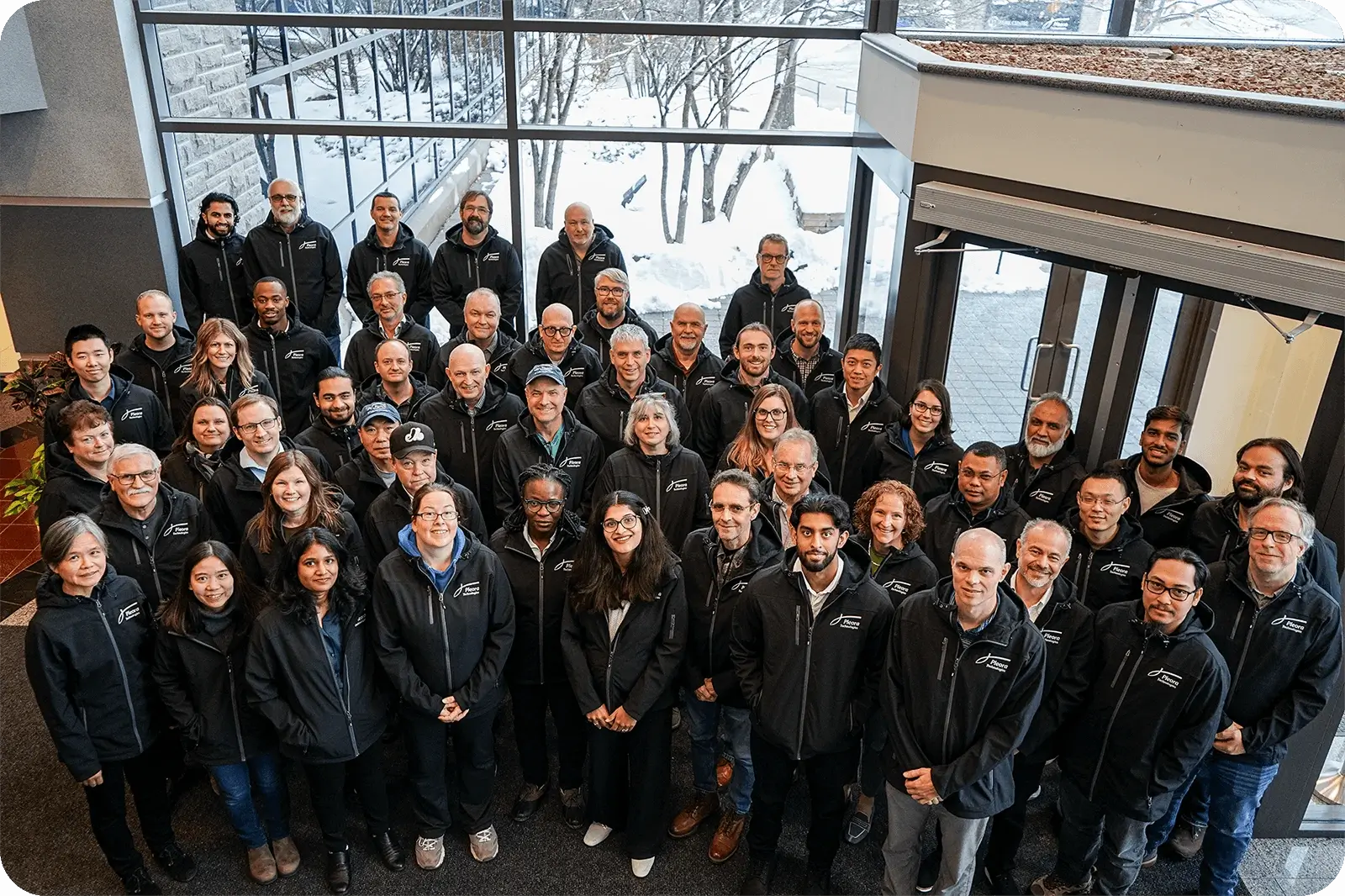Who We Are
Global manufacturers rely on Pleora’s real-time connectivity software and hardware solutions, standards knowledge, and systems expertise for mission-critical applications in the industrial automation, medical, and security & defense markets. Machine vision device and system manufacturers have designed our products into industrial cameras, X-ray panels, robotics, transportation, monitoring, and quality inspection systems, and more for over two decades. Our solutions help bring new products to market quickly, while reducing risk and lowering costs.
Headquartered in Canada’s tech capital Ottawa, Pleora has 75 employees in engineering, sales, and support with global locations in North America, Europe, and Asia.

Milestones
2025
Pleora proudly turns 25 in 2025, and celebrates with a new and improved facility, remaining in Canada’s largest tech park, the Kanata NBIA.
Kicking off the year, Pleora introduces new GEV to Thunderbolt external frame grabber, which provides cost and design flexibility advantages by converting GigE Vision cameras into native PCIe cameras that transport high-speed imaging data over Thunderbolt cabling.
2024
Pleora relases new patented RapidPIX™ lossless compression technology that increases data throughput by almost 70 percent while meeting the low latency and reliability demands of machine vision and medical imaging applications.
2023
Pleora and Skoopia proudly introduce the industry’s first external frame grabber that adds GigE Vision connectivity to Skoopia’s 21Z30S series block cameras.
2022
Pleora’s platform for manufacturers, Vaira, wins a Vision Systems Design 2022 Innovators Award as new solution to automate and digitize manufacturing processes.
2021
Pleora’s AI Gateway is recognized as an industry-best product in the Vision Systems Design 2021 Innovators Awards Program.
2020
Pleora introduces the AI Gateway, the vision industry’s first platform that simplifies the deployment of advanced machine learning AI capabilities to improve the reliability and lower the cost of visual quality inspection and announces technology partnerships with Neurocle and PerClass.
2019
Pleora’s RuggedCONNECT Smart Video Switcher wins “Best in Show” from Military Embedded Systems at DSEI 2019. In addition, the company announced new RuggedCONNECT plug-in AI capabilities for tank detection and driver awareness to enhance battlefield awareness.
2018
Pleora begins trialing its video and sensor networking technologies with lead customers designing situational awareness systems for military ground vehicles. The company’s technology is used to network multiple cameras and data sources with display panels and mission computers over a real-time Ethernet connection.
2017
Pleora’s GigE Vision over NBASE-T embedded interface wins the inVision Top Innovation 2017 award and is recognized in the Vision Systems Design 2017 Innovator Awards Program. Lead customers begin preliminary designs of X-ray flat panel detectors and imaging systems integrating the revolutionary new technology.
2016
Pleora is the first to demonstrate GigE Vision over NBASE-T – which enables up to 5 Gbps video transmission over standard copper cabling. The company becomes the first vision company to join the NBASE-T Alliance.
2015
Pleora earns a Vision Systems Design Innovator Award for a technology concept that converts video from GigE Vision or USB3 Vision cameras into the H.264 compression format.
2014
Pleora introduces the market’s first external frame grabber that transforms Camera Link cameras into USB3 Vision cameras, and an embedded hardware solution that allows manufacturers to integrate IEEE 802.11 wireless connectivity into imaging systems.
2013
Pleora releases the industry’s first video interface for USB3 Vision.
2012
Pleora demonstrates a video interface for GigE Vision over 802.11n wireless achieving up to 200 Mb/sec uncompressed video transfer.
2010
Pleora is awarded a patent for a method and system for reliable management of multiple devices over a network bus – an innovation that underpins communications in the company’s GigE products.
2010
Pleora introduces a frame grabber for video delivery over 10 Gigabit Ethernet. Embedded hardware for integrating 10 GigE into systems and cameras soon follows.
2008
Pleora is awarded a patent for a Massively Reduced Instruction Set Processor. This novel technology allows for significantly lower power consumption and costs, as well as a smaller footprint.
2007
Frost & Sullivan honor Pleora with the “Product Innovation in Machine Vision” award.
2006
Pleora’s PT1000-CL External Frame Grabber completes its first NASA shuttle mission. Mounted at the end of the space shuttle’s 50-foot robotic arm, the crew visually inspects the shuttle’s heat tiles for signs of damage before returning to Earth.
2003
Pleora co-founds the GigE Vision Standard Committee, bringing together a diverse group of global camera, software, and frame grabber companies to standardize the delivery of video and image data over Gigabit Ethernet networks. The first version of the standard is released in 2006.
2003
Pleora enters into its first collaboration with a camera manufacturer and its embedded hardware is integrated into the first-ever Gigabit Ethernet camera.
2002
Pleora opens its doors to customers with the unveiling of its first product, the PT1000-CL external frame grabber, which allows Camera Link cameras to deliver video over Gigabit Ethernet.
2000
George Chamberlain and Alain Rivard establish Pleora with the objective of delivering video over Ethernet for performance applications that require real-time analysis.